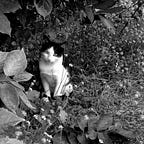The temptation of a dead fruit
It was Ramadan in El Aaiún, Spanish Sahara, 1975. Still hot during the day at the rim of the deserts. The cloudless cerulean sky as usual, but the day was getting shorter.
Sitting barefoot at the doorstep, she accidentally saw an object, something glittering in the dirt of the street. She leaned forward and picked it up. It was made of a slightly rusted but nicely polished brass strip carefully wrapped by a piece of galvanised iron, concatenated on a hemp string with a tiny sack and a heart-shaped fruit kernel. What a beautiful craft, she thought, like the ones Sahrawi women wore. But who could have forgotten it? She showed it around trying to find the owner of this pendant, but the neighbourhood kids were so scared when they saw it, that they ditched their bikes, ran away and hid.
What followed was a deluge of misfortune, a series of inexplicable sufferings and physical harms which Sanmao, a Taiwanese writer, would not have endured if not for the timely help of her frightened Sahrawi neighbours¹.
Who, at least the non-locals and the Spanish colonists alike, would have known that the piece of art contained the deadliest sorcery of the Mauritanian black magic? Why was it there, and who littered it on the street outside her house, in a quiet neighbourhood Sanmao lived with her Spanish husband, Jose, an ocean engineer and scuba diving enthusiast. She surely would not have picked up if it were not so beautiful.
And what was the role of art or artistic expression here?
If the black magic sorcerer, at the time of writing the curse on paper and crafting it into the enclosure, had any aesthetics idea towards recognising its enticing potential, then the art might have, in this tragic case, been explicitly given its utilitarian function as a mean of partially-succeeded colonial resistance. Its failed attempt symbolised what was about to descend for years to come until the present moment: the failed revolt against the Moroccan occupants by the Frente Polisario, and as a consequence, the dire condition of displaced Sahrawi people in refugee camps. It also looked like an autonomous response against Sanmao’s voyeuristic stories of everything juicy and exotic. It unexpectedly piqued her interest in the realm of the unknown and served as a premonition of her own self-destruction.
Or it was not the black magician’s intention to assign any voluntary function of the art to the object. Perhaps consciously the black magician was not thinking of art-making. Its aesthetics value, output as a function of its intricate forms and colour arrangement, was generated and transfixed onto it by Sanmao. The value was only lifted after the deadly engagement was aborted and went back to its floating state before the object was destroyed by the local Imam. Only those who upheld and appreciated the artistic value, like many who pillaged or rummaged through aboriginal villages for precious artworks and were unaware of the danger, fell into their own peril.
Many of the collected artworks of similar kinds are still, from time to time, being wheeled out from storage and publicly displayed, despite objections from descendants of the original owners or aboriginal people. In an ultra-modern world that demands unanimous viewing experiences, there does not seem to be any room for secrecy or personal differentiation. What if there is something that one ought not to see?
- Sanmao. “Seed of Death.” Stories of the Sahara, translated by Mike Fu, Bloomsbury, 2020.
